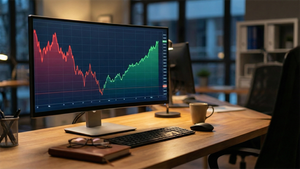
The U.S. stock market experienced a notable downturn today, November 6, 2025, as investors grappled with growing apprehension over the lofty valuations of artificial intelligence (AI) stocks and a significantly deteriorating job market. Major indices, including the S&P 500, Nasdaq Composite, and Dow Jones Industrial Average, registered sharp declines, signaling a palpable "risk-off" sentiment sweeping across financial markets. This market recalibration reflects a deeper re-evaluation of growth prospects and a shift towards greater caution, challenging the "buy the dip" mentality that has characterized recent bull runs.
The immediate implications of this downturn are a period of heightened volatility and a significant reassessment of investment strategies. Investors are increasingly moving towards safer assets, such as government bonds and gold, as the sustainability of current AI hype and the health of the U.S. labor market come under intense scrutiny.
A Perfect Storm: AI Bubble Fears Meet Labor Market Weakness
Today's market slide is the culmination of mounting anxieties that have been simmering beneath the surface of an otherwise robust, AI-fueled market rally. The primary drivers are two-fold: an escalating concern over a potential "AI bubble" and a grim outlook for the U.S. job market.
Analysts and financial institutions, including the Bank of England's Financial Policy Committee, have increasingly warned that equity market valuations, particularly within the technology sector focused on AI, appear stretched. The "Magnificent Seven" AI-related stocks—Nvidia (NASDAQ: NVDA), Amazon (NASDAQ: AMZN), Apple (NASDAQ: AAPL), Microsoft (NASDAQ: MSFT), Tesla (NASDAQ: TSLA), Alphabet (NASDAQ: GOOGL), and Meta Platforms (NASDAQ: META)—all experienced one-day falls in early November 2025, underscoring the broad impact of these valuation concerns. Despite massive investments in AI, particularly into a select group of companies like OpenAI and Nvidia (NASDAQ: NVDA), tangible returns on investment have been slow to materialize, prompting questions about the sustainability of the current AI frenzy. Notorious hedge fund investor Michael Burry, famed for his accurate bet against the 2008 housing market, has reportedly shorted major AI players like Nvidia (NASDAQ: NVDA) and Palantir (NYSE: PLTR), further fueling investor jitters.
Compounding the AI valuation concerns are alarming signs from the U.S. labor market. A recent report from Challenger, Gray & Christmas revealed that October 2025 saw the highest number of job cuts since 2003, with U.S. employers announcing 153,074 terminations. This represents a staggering 175% increase from October 2024 and 183% from September 2025. Year-to-date, total job cuts have reached 1,099,500, a 44% increase over all of 2024, making 2025 the worst year for layoffs since 2009. Technology businesses have been particularly hard hit, leading private-sector layoffs as companies streamline operations and restructure, partly driven by AI adoption. The absence of official U.S. economic data due to an ongoing federal government shutdown has forced investors to rely on these private reports, intensifying fears of a slowing U.S. economy despite an earlier stronger-than-expected ADP report.
Navigating the Volatility: Winners and Losers Emerge
The current market downturn is creating a challenging environment, differentiating between companies with solid fundamentals and those whose valuations were propped up by speculative AI enthusiasm.
Companies and sectors most likely to lose include:
- Overvalued Pure-Play AI Companies and Undifferentiated AI Startups: These firms, often characterized by high cash burn, unproven profitability, and valuations based on speculative future growth, face immense pressure. Palantir Technologies (NYSE: PLTR), despite exceeding earnings, has seen significant stock declines due to its extreme valuation multiples. Nvidia (NASDAQ: NVDA), while an AI enabler, carries significant concentration risk with its $5 trillion market capitalization, and its exponential demand growth is now being questioned. OpenAI, despite substantial revenue, has also reported significant losses, raising concerns about high capital expenditures and potential losses for partners like Oracle (NYSE: ORCL) and Broadcom (NASDAQ: AVGO). Adobe (NASDAQ: ADBE) is facing increasing competitive headwinds from new generative AI solutions.
- Cyclical Industries (Consumer Discretionary, Travel, and High-End Retail): These sectors are highly sensitive to economic fluctuations and consumer spending. Job worries and declining consumer confidence directly impact demand for non-essential goods and services. This includes automobile manufacturers, airlines, hotels, luxury goods producers, and non-essential retailers like DoorDash (NASDAQ: DASH), which has already seen significant stock declines.
Conversely, companies and sectors most likely to win or exhibit greater resilience include:
- Defensive Sectors (Consumer Staples, Healthcare, Utilities): These sectors provide essential goods and services with inelastic demand, offering stable revenue streams and lower volatility. Examples include Procter & Gamble (NYSE: PG), Coca-Cola (NYSE: KO), PepsiCo (NASDAQ: PEP), Walmart (NYSE: WMT), Costco (NASDAQ: COST), Johnson & Johnson (NYSE: JNJ), Pfizer (NYSE: PFE), and utilities like Dominion Energy (NYSE: D), which could benefit from increased power demands from AI data centers.
- Companies Leveraging AI for Demonstrable Cost Reduction and Efficiency: Businesses that effectively implement AI to streamline operations, cut costs, and enhance productivity will gain a competitive edge. Examples include Albertsons (NYSE: ACI), Booking Holdings (NASDAQ: BKNG), and General Mills (NYSE: GIS), all actively using AI for optimization and cost savings. IBM (NYSE: IBM) has already achieved billions in cost savings through its AI-enabled transformation. Automation software providers like UiPath (NYSE: PATH) and data center REITs, along with power/cooling infrastructure providers like Schneider Electric (OTCMKTS: SBGSY), also stand to benefit from the foundational needs of AI deployment.
- Government & Defense Services: Funded by government budgets, these sectors are less susceptible to market fluctuations.
- Energy Sector (Selective Exposure): Essential for daily life, the energy sector maintains baseline demand, with natural gas producers potentially seeing increased demand.
Broader Implications: A Shifting Economic Landscape
This market downturn is more than a fleeting correction; it signifies a deeper rebalancing within the broader economic and technological landscape.
The U.S. economy is undergoing a delicate rebalancing act, with moderating jobs data and slowing wage growth contributing to disinflationary pressures. However, inflation is still projected to remain above target, potentially reaccelerating due to tariff-induced price hikes, leading to increased market volatility amidst policy uncertainty. Reduced consumer confidence is expected to lead to decreased consumer spending and investment, impacting global sectors reliant on U.S. demand. Experts are also warning about systemic risks posed by AI, drawing parallels to past tech bubbles. Concerns include third-party dependencies on a few dominant AI providers, increased market correlations, cyber risks, and model risk due to the opacity of AI systems. The massive market capitalization of single companies like Nvidia (NASDAQ: NVDA) creates systemic risks extending beyond individual company performance to broader market stability. Some economists even suggest an "AI-fueled jobless profit boom," potentially leading to a low-inflation, low-employment economy.
The downturn fits into broader industry trends, including widespread AI bubble concerns, with over half of investors believing AI stocks are in a bubble. The massive capital expenditures by Big Tech in AI infrastructure are being scrutinized, as historical analysis suggests infrastructure booms often result in overinvestment and poor stock returns. The labor market is rebalancing away from previous years' extreme tightness, with slowing job creation and an uptick in unemployment. While AI could lead to massive job losses in the next decade, some believe new job opportunities will arise, though certain tech industries have already seen job growth plateau since the release of ChatGPT.
Ripple effects will be significant, potentially leading to a global economic slowdown, increased supply chain disruptions, and more challenging long-term investment decisions for businesses. Less resilient competitors may face immense pressure, leading to market consolidation. Regulatory bodies like the Bank of England, IMF, and Financial Stability Board (FSB) are raising alarms about systemic risks from AI market concentration, increased market correlations, cyber risks, and model opacity. Antitrust investigations into AI market concentration and changes to securities regulations affecting AI company reporting requirements are anticipated. There's also a growing push for robust AI governance frameworks, including ethical review boards and algorithmic transparency, amidst a fragmented regulatory landscape with numerous state-level AI laws emerging. Litigation risks, particularly related to "AI-washing" (exaggerated claims about AI capabilities), have also surged.
Historically, the current situation draws frequent comparisons to the Dot-Com Bubble of the late 1990s and early 2000s, characterized by massive investment in transformative technology, soaring valuations, and a disconnect between valuations and traditional financial fundamentals. Similarities include extreme valuations based on future potential, widespread speculation, and circular financing arrangements within the AI sector. Other historical events like the Dutch Tulip Mania and the South Sea Bubble also serve as cautionary tales of speculative frenzies. While the labor market has historically adapted to technological disruption, some economists warn that the AI bubble could be "worse" than the dot-com crash due to perceived higher overvaluations in some leading AI companies.
What Comes Next: Navigating a Transformative Period
The path forward for the U.S. stock market is marked by both significant opportunities and considerable challenges, necessitating strategic pivots and adaptations across industries.
In the short term (late 2025 - early 2026), the market is expected to remain volatile, with moderated gains. The "recalibration in investor expectations" towards fundamentals and profitability will continue. The cooling job market, with potential for further unemployment rate increases, coupled with a prolonged U.S. government shutdown, will maintain investor nervousness. However, underlying economic resilience and anticipated Federal Reserve interest rate cuts in response to a softening labor market could provide some downside protection.
Long-term possibilities are bifurcated. An "exceptionalism" scenario could see the AI revolution massively boost U.S. productivity and sustain higher economic growth. However, if the "AI narrative falters" in 2026, a mild recession is a distinct possibility. The most profound long-term concern remains job displacement due to AI and automation, with projections of up to 100 million jobs lost in the next decade, potentially leading to increased social strife. The future workplace is envisioned as a "hybrid" model where AI augments human capabilities, but the concept of a "safe" white-collar job may erode, leading to a "K-shaped" recovery where AI beneficiaries thrive while others struggle.
Strategic pivots for companies will involve rethinking workforce and upskilling, focusing on profitability and fundamentals, embracing human-centered AI, and strengthening risk aversion and resilience. Businesses must prioritize clear AI use cases with a path to financial viability, cultivate AI literacy, and develop uniquely human "soft skills."
Market opportunities lie in specialized AI applications (education, cybersecurity, fintech, healthtech, climate tech), continued demand for core AI infrastructure (semiconductors, software), robust venture capital funding for AI startups, and growth in emerging markets leveraging AI. Defensive sectors, quality fixed-income investments, and cash-rich growth franchises with clear AI monetization strategies may also show resilience. New job creation, particularly in human-AI collaboration roles, is also anticipated.
Key challenges include the lingering AI bubble concerns, significant job displacement and skill gaps, a widening "AI divide" between advanced and low-income economies, operational and economic headwinds (data quality, integration complexities, supply chain disruptions), and market concentration risk.
Potential scenarios range from a "Recession" Risk Scenario with significantly weakened employment and higher inflation, to an "Exceptionalism" Scenario of massive AI-driven productivity and economic growth. A "K-shaped" Recovery is plausible, where AI beneficiaries thrive while others lag. Alternatively, a scenario of Moderate Growth with Volatility could see continued market choppiness, supported by economic resilience and rate cuts, but weighed down by geopolitical risks and trade policy uncertainty.
Comprehensive Wrap-up: Navigating the New Normal
Today's U.S. stock market downturn underscores a pivotal moment in financial markets, driven by a confluence of AI valuation concerns and significant job market anxieties. The key takeaway is a fundamental shift in investor sentiment, moving from speculative growth to a demand for demonstrable value and sustainable profitability.
Moving forward, the market will likely remain highly sensitive to further economic data, particularly labor market reports, and any developments regarding AI's real-world profitability versus its current hype. While AI presents transformative opportunities for long-term growth and productivity, the immediate concerns around valuation and job displacement are creating significant short-term headwinds.
Investors should watch for several key indicators in the coming months:
- AI Profitability: Evidence of AI companies translating massive investments into sustained, tangible profits.
- Labor Market Trends: Further reports on job cuts, unemployment rates, and wage growth.
- Federal Reserve Policy: The timing and extent of interest rate cuts, which will be crucial for market liquidity and investor confidence.
- Regulatory Developments: Any new policies or frameworks aimed at governing AI, which could impact market concentration and operational costs for tech firms.
- Corporate Adaptations: How companies pivot their strategies, particularly in workforce development and AI integration, to navigate this evolving landscape.
The current period demands a nuanced approach, separating genuine innovation from speculative fervor. Companies that strategically adapt their workforces, embrace human-centered AI, and focus on fundamental profitability will be best positioned to navigate the challenges and capitalize on the emerging opportunities in this evolving market.
This content is intended for informational purposes only and is not financial advice





